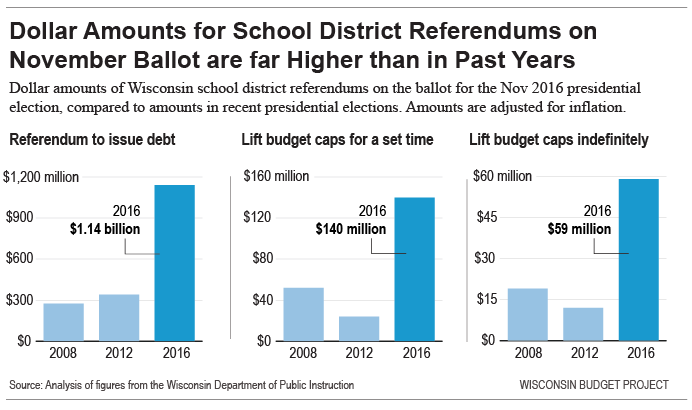School Referendums Exploding
Dozens on November ballot statewide, totaling $1.34 billion, many times higher than any previous election.
On Tuesday, voters in dozens of school districts across the state will determine whether to provide additional resources to children in public schools. The dollar amount school districts are asking voters to approve is far larger than the amounts that were on the ballot for the 2012 or 2008 presidential election.
Next week, school districts will ask voters to approve:
- $1.14 billion in borrowing for new construction and building updates:
- $140 million in increases to school district budgets. These increases boost school district budgets for a set period of time and then expire, at which point school districts revert to their previous budget levels; and
- $59 million in increases to school districts budgets on a recurring basis.
The requested amounts dwarf the amounts on the ballot for the two most recent presidential elections. The amount of borrowing that is on the ballot this November is three times higher than the proposed amount four years ago; the proposed amounts for non-recurring increases in budget caps is six times higher than it was four years ago, and five times higher for referendums to lift the budget caps on a recurring basis. Amounts are adjusted for inflation.
The dramatic increase in referendum amounts has two root causes: First, in 2011 state lawmakers significantly reduced state support for public schools and also limited the amount of money school districts were allowed to spend on each student. Since then, lawmakers have allowed either small or no increases in the caps they impose on school district budgets, making it difficult for school districts to absorb rising costs without reducing classroom resources. A Wisconsin Public Radio story describes how the changes in state support are pushing rural school districts to ask for more resources at the ballot box:
“Wisconsin’s rural school districts are increasingly relying on asking voters directly for money in response to the decreasing amount they’re receiving in state funding over the past half decade.
‘It’s kind of the way budgeting is going right now,’ said Kim Kaukl, executive director of the Wisconsin Rural Schools Alliance. ‘Over the last four to five years, that’s the way many of the districts plan their budgeting just because there’s such a shortfall on what the state is providing financially.’”
Another reason for the increase in school district referendums is that some state lawmakers have signaled they want to limit the ability of school districts to ask voters to approve new resources. Earlier this year, lawmakers considered a proposal that would have limited the circumstances under which school districts can go to referendum. That proposal didn’t receive a floor vote, but proposals that are unsuccessful in one legislative session often pop up again later. School board members in at least one district – Madison – specifically pointed to concerns that legislators might limit school district referendum options as a reason to move forward with a referendum now, rather than later.
Schools shouldn’t need to go to referendum to avoid making deep cuts to academic programs. The large referendums on the ballot this election are a sign that the freeze on school district budgets is harming educational opportunities for students. It’s also a sign that Wisconsin residents value public education and want opportunities to invest in public schools.























if ten percent of the schools have to get additional money, every yea,r are they mismanaged?
What abut the other 90%? Why toss in more money?
We have seen a tenfold increase in school spending, since 1970 ,for 50% fewer kids yet the cry for more money?
Have they cut non teaching employees?
The scores have gone down, no matter how,such money you give the schools.
Ask Mark Zuckerberg what happened to his 100 million? Nothin!